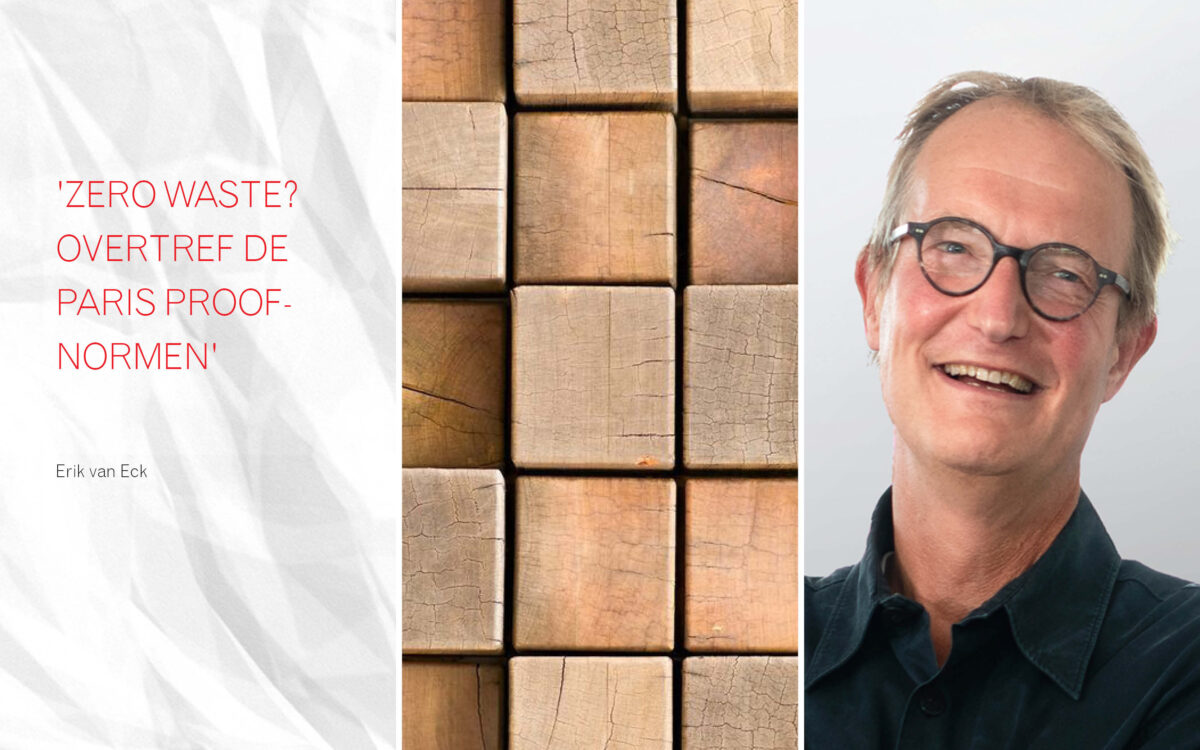
BLOG: Zero waste? Exceed Paris Proof standards
20 November 2023
By: Erik van Eck
How is the circular economy evolving after the election? That question should occupy a lot of boardrooms and me too. In addition to being an architect, as a Broekbakema partner I also feel I am a circular entrepreneur. Making an impact for ‘zero waste’ requires the courage to pioneer and especially to invent the wheel together. That motivation is growing among clients and chain parties, but how far would the Dutch building industry be without climate agreements and the government as a big stick?
CHOOSE THE SUPERLATIVE
A question of conscience? If it were up to me, eyes would be less focused on The Hague. Fortunately, more and more front-runners are raising the bar of their own accord and it is for such parties that I prefer to work. ABN AMRO or DSM for example, together with supply chain partners we designed an office for both companies with which we already exceeded the Paris Proof guidelines in some respects.
WITHOUT READY-MADE ANSWERS
See, from this kind of ambition and commissioning, the chain becomes a lot more creative and innovative. It also keeps me on my toes, so it’s extra fun. How does that work? You start by working out several design models to organize the program as optimally as possible. Then you search together for the optimal facade area and footprint in combination with maximum flexibility of the shell and the main supporting structure. Even though no one has the ready-made answers, you go for minimal environmental impact and future value retention. With that shared mission, you are pushing the boundaries of what is possible.
KEEPING EACH OTHER FOCUSED
That quest requires a different mindset, which is the beauty of pioneering. You become more inventive together if you really dare to keep each other on your toes. The building design for ABN AMRO and DSM speaks volumes in that respect. Both projects score well in terms of MPG (Buildings Environmental Performance). DSM has an MPG score of €0.56 and ABN AMRO of €0.42 while the legal standard is €1 for new non-residential buildings. Much is possible as long as you challenge each other, invest and also tolerate what is necessary from each other because you know that much is still in its infancy.
ALSO IN THE BUSINESS CASE
And yes, without friction no shine. That also applies to how parties must find each other again and again in the transition to circular construction. I too am experiencing this and it is precisely then that it is important to continue the dialogue with each other. For example, circularity puts the business case for new construction and transformation in a new light. How do you decide on investment versus return? In the circular economy you can only answer that if you consider the total life cycle but that is relatively new to the construction world.
TAKING MANAGEABLE RISKS
How do you work toward such new work standards? The urgency and speed with which need not depend on legal frameworks or subsidies because responsibility for the climate belongs to all of us. We can move faster even if the proven solutions are not yet on the table. Innovation does not require the world to be turned upside down immediately; Rome was not built in a day. Lasting innovation happens by doing, taking risks little by little so that the changes remain manageable.
SOCIAL OBLIGATION
In the face of manageable risks, the development of applied knowledge also demonstrates to me a sense of social responsibility. It is the costly duty of all of us to pull out all the stops to flip the switch from linear to circular. History teaches us how that works with small actions. I remember as an architect in the late 1990s jumping on the bandwagon of sustainable building. There were no frameworks yet so we just started. The motto was just do it, not words but deeds, as we say in Rotterdam.
RAISING THE BAR GRADUALLY
With each project, this resulted in new knowledge and insights, and gradually more sustainable buildings. This attitude was contagious and from 2006 the sense of urgency on the other side of the table increased noticeably. A common sustainability standard also emerged in the collaboration with our clients. The ambitions were often already on the table when we arrived; our clients themselves raised the bar. It is now exactly ten years since Broekbakema was thus selected for the design of Groningen’s Energy Academy Europe.
HISTORY REPEATS ITSELF
The building won the international Breeam award in 2017 with its Breeam Outstanding score, making it the first educational building in the Netherlands with such a high sustainability rating. Over the years, we have also achieved a lot with this knowledge in other projects. From those days of energy sustainability, I recognize the transition mechanisms and I now have that pioneering feeling of those days again, this time with the compactness of buildings and the application of circular materials.
CIRCULAR BUILDING MODEL
Again, bit by bit, it provides a lot of knowledge and insights. By now we already know so much more about the ideal building model based on material efficiency, flexibility, future value but also nature inclusiveness and climate adaptation. We are currently working on a model to share that knowledge and help clients with a circular building strategy and business case. No one needs to wait for The Hague to do that, it all starts with the right mindset. Just do it!
Erik van Eck
Architect-director